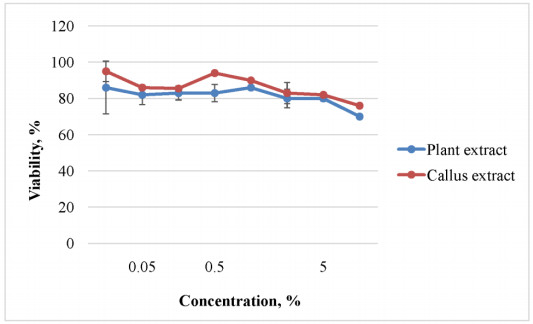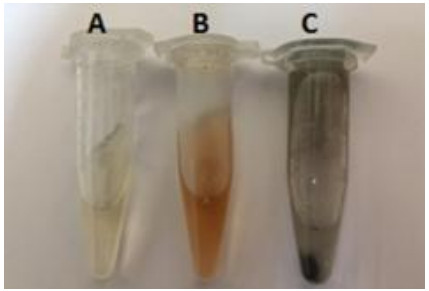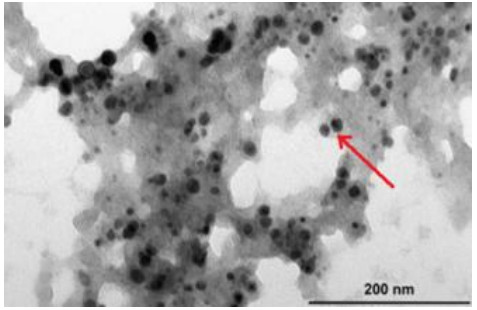1.
Introduction
At present, synthesis of metal nanoparticles and their oxides using plant extracts has become widespread. Green synthesis has been considered an environmentally friendly and cost-effective alternative to physical and chemical synthesis methods [1]. Plant extracts provide an available, cheap and non-toxic raw material for high-scale nanoparticles production. The technology is based on the ability of plant extracts secondary metabolites, such as phenolic acids, flavonoids, alkaloids and its derivates, as well as reducing sugars and amino acids to reduce metal ions [2]. Green synthesis provides to obtain nanoparticles of controlled shape and size, not involving the use of toxic reagents and physical factors. The technology is safe, scalable, reproducible and environmentally friendly [1].
In recent years, nanoparticles of various nature and morphology have been obtained in accordance with green synthesis technology. There are many published studies on the production of zinc, cobalt, cerium iron oxides nanoparticles as well as silver and gold. The nanoparticles can form rounded, elongated or plate-likes shape [3,4,5,6]. The potential applications of green synthetized nanoparticles are also diverse. They can be used in medicine in cancer therapy, targeted drug delivery systems, substances that absorb UV radiation, cytotoxic agents [7,8]. In agriculture, green nanoparticles are used as nanofertilizers, nanopesticides or plant growth stimulants [9,10]. Nanoparticles are most commonly used as antimicrobial agents. Antibacterial activity against various pathogenic strains has been established for green nanoparticles of zinc oxide, iron, copper and, above all, silver. There are various theories on the silver nanoparticles action on bacterial cells to cause antimicrobial effect. Silver nanoparticles can change bacterial cells membranes structure by penetrating cell walls. Their large ratio of surface area to volume makes them more effective. Another mechanism by which the cells die includes the formation of free radicals by the silver nanoparticles. The free radicals damage the cell membrane which can lead to cell death [11,12].
The application of silver nanoparticles as antibacterial agents in medicine and agriculture can reduce the use of antibiotics and avoid the appearance and limit the spread of strains resistant to antibiotics.
The problem of bacteria infectious resistance is especially serious in hospitals, where are elderly patients with severe illnesses or patients treated with immunosuppressive drugs.
Green synthetized silver nanoparticles can be used not only as antibacterial agents. They also have catalytic properties for environmental pollutants degradation [13,14], use as optical sensors for pharmaceutical detection [15] and water pollutant detection [16], medical device coatings [17], drug delivery systems [18], anticancer agents [19]. Thus, silver nanoparticles are increasingly used in medicine and healthcare, food-processing and industry.
In the present work, we have obtained silver nanoparticles using aqueous extracts of Agastache foeniculum plants and callus. A. foeniculum is a medicinal plant from Lamiacea family which contains a wide range of secondary metabolites such as phenylpropanoids, terpenoids, phenolic acids, flavonoids, lignans [20]. This is related to the choice of A. foeniculum as an extract source for silver nanoparticles synthesis.
The purpose of this study was to estimate the antibacterial activity of obtained silver nanoparticles on 5 hospital bacterial infections, as well as to assess their size and shape. In the extracts used for synthesis, the total content of substances with an antioxidant activity - phenols and flavonoids was determined. The extracts were also characterized by low cytotoxicity, which indicates the safety and effectiveness of their use in the technology of nanomaterials green synthesis.
2.
Materials and methods
A scheme of the experiment is presented in Figure 1.
2.1. Plant extracts preparation
A. foeniculum plants and callus, obtained on Murashige and Skoog medium containing 0.5 mg/L 2, 4-dichlorophenoxyacetic acid and 0.1 mg/L kinetin, cultivated for 1 month, were ground in liquid nitrogen to obtain a fine powder. Distilled water was added to the crushed raw material in a ratio of 1:2.5 (by weight), stirred and boiled in a water bath for 30 minutes. Then the mixture was filtered through 2 layers of gauze and centrifuged for 10 minutes at 16,000 g to clean the extract. The supernatant was used to carry out the reaction for nanoparticles synthesis [6].
2.2. Plant extracts characterization
2.2.1. Evaluation of total phenolic and flavonoid content
To estimate total phenolic content of extracts Folin-Ciocalteu method was used. To the filtered plant and callus extracts (0.5 ml) 3 ml of distilled water, 0.5 ml of Folin-Ciocalteu reagent and 1 ml of saturated soda solution (8%) were added. The total volume was brought to 5 ml with distilled water. Total phenolic content was determined spectrophotometrically after 1 hour at a wavelength of 765 nm [21]. The experiment was carried out in triplicate. The calibration curve was built using hydroquinone standard solutions.
To estimate total flavonoid content the exact extract volume (about 1 ml) was placed in a 10 ml flask, 3.7 ml of distilled water and 0.3 ml of a 5% aqueous solution of NaNO2 were added. After 5 minutes, 0.3 ml of 10% AlCl3 aqueous solution was added to the mixture. After 6 minutes, 2 ml of 1M NaOH solution was added. After thorough mixing, the absorbance of the resulting solution was measured at 510 nm [22]. The experiment was carried out in triplicate. The calibration curve using quercetin standard solutions was built.
2.2.2. Evaluation of cytotoxic activity of plant extracts
The cytotoxicity of aqueous extracts was investigated using the MTT test. SK-OV-3 cells were plated onto a 96-well plate at 7.5 × 103 cells per well in 150 μl of McCoy's 5A medium with 10% FBS (Fetal Bovine Serum). After culturing the cells at 37℃ in a CO2 incubator overnight, 50 μL of PBS (phosphate buffered saline) (137 mM NaCl, 2.7 mM KCl, 4.77 mM Na2HPO4·2H2O, 1.7 mM KH2PO4, pH 7.4) as a negative control and 50 μl of PBS containing test samples at various concentrations. The cells were incubated for 20 h at 37℃ in the CO2 incubator. Then the medium was shaken, the cells were washed once with the medium. After that, 100 μL of a solution of 3- (4, 5-dimethyl-2-thiazolyl)-2, 5-diphenyl-2H-tetrazolium bromide - MTT (0.5 g/L in McCoy's 5A) was added to the wells, incubated for 1 h at 37℃ in an atmosphere with 5% CO2. After this time, the MTT solution was removed and 100 μl of dimethyl sulfoxide (DMSO) was added to the contents of the wells, the plate was shaken until the formazan crystals were completely dissolved. The optical density of the contents of each well was measured on an Infinite M100 Pro plate analyzer (Tecan, Austria) at a wavelength of λ = 570 nm.
2.3. Green synthesis of silver nanoparticles and its characterization
2.3.1. Synthesis and UV-spectroscopy
To determine the optimal concentration of salts and plants extracts for the synthesis of silver nanoparticles, 20 μl of AgNO3 at a concentration of 5, 25, 50, and 100 mM was mixed with 500 μl of extracts in two- four- and eight- fold dilution. The synthesis time for silver nanoparticles was 2 hours at room temperature. After that, the absorption spectra were recorded, which were used to determine the optimal concentration of the starting components for the synthesis. Absorption spectra were measured in the range 390 to 600 nm using a Hitachi UV-2600 spectrophotometer. It is known that noble metals have a unique optical property of surface plasmon resonance [23]. The peak intensity reflects the efficiency of nanoparticle synthesis. The formation of silver nanoparticles is indicated by a change in the color of the reaction mixture and absorption spectra in the UV range. The appearance of a surface plasmon resonance peak in the 430 to 460 nm wavelength range indicates the formation of silver nanoparticles [24].
2.3.2. Transmission electron microscopy
A LEO912 AB OMEGA transmission electron microscope (TEM) operating at 100 kV was used to obtain an image of the synthesized nanoparticles and determine their size. Nanoparticles samples were diluted 1:10 and 1:100 and dropped onto copper grids covered with a formvar film, which were then dried in air.
2.4. Antimicrobial activity estimation
To determine the minimum inhibitory concentration of the silver nanoparticles, bacterial strains clinical isolates from the local collections of N. F. Gamaleya Research Center (Moscow, Russia) were used:
(1)
Staphylococcus aureus, strain Z 73-14, a globular gram-positive bacterium, causes a wide range of diseases from mild skin infections to pneumonia and meningitis;
(2)
Staphylococcus haemolyticus, strain F 1059-16, a gram-positive microorganism that causes various purulent inflammations;
(3)
Klebsiella pneumoniae, strain Ts 45-16, a gram-negative facultative anaerobic rod-shaped bacterium, the causative agent of pneumonia;
(4)
Acinetobacter baumannii, strain Ts 50-16, a gram-negative microorganism causes opportunistic diseases;
(5)
Streptococcus pneumonia, strain R 363-17, a gram-positive microorganism, the main causative agent of meningitis, otitis media, sinusitis, pneumonia.
An overnight bacteria culture (5 ml) was diluted and grown to optical density OD600 = 0.6. The resulting culture (2 ml) was precipitated by centrifugation (3000 g, 10 min), The cells were resuspended in the same volume of 5 mM HEPES-HCl, pH 7.2; the turbidity of the resulting suspension should correspond to the McFarland 0.5 turbidity standard. Then the bacterial culture was diluted 100-fold with the same buffer (the final cell density is 106 cells/ml).
In all wells of the plate, 100 μl of LB medium and 100 μl of nanoparticles preparation were added. Then, the preparation was titrated in 100 µL in subsequent rows according to the scheme (Table 1) [25].
100 μl of bacterial suspension was added to the prepared wells. To control growth (GC), a mixture of 100 μl of bacterial suspension and 100 μl of medium was added to one of the rows. The row containing only the culture medium is sterility control (SC).
The resulting mixtures were incubated at 37℃ for 16 to 20 hours, after which they were visually compared with the control for the presence of a bacterial sediment.
The minimum inhibitory concentration (MIC) is defined as the lowest concentration of nanoparticles that inhibits microorganism's growth s in the plate wells.
3.
Results and discussion
3.1. Total phenolic and flavonoid content estimation
The results of total phenolic and flavonoid content estimation are presented in Table 2. The total phenolic content of callus extract is higher than total phenolic content of plant extract. However, the total flavonoid content was higher in plant extract.
Supposedly the total content of substances with antioxidant activity, such as phenolic compounds, affects nanoparticles morphology and size during synthesis. For example, sodium borohydride, a strong reducing agent was used for the synthesis of monodisperse and uniform-sized silver colloids to achieve control morphology and structure [26]. The use of dedifferentiated plant cells as a source of substances with reducing activity is promising. Callus tissue can differ in secondary metabolites profile from original plant and accumulate more substances with reducing activity. The use of callus as a raw material facilitates extraction procedures. There is a prospect of obtaining nanoparticles directly in a reactor in a medium for plant cells cultivating.
3.2. Cytotoxicity estimation of A. foeniculum aqueous extracts
In this experiment, the cytotoxic properties of aqueous extracts were estimated. The experiment was carried out on human ovarian carcinoma cells SK-OV-3.
When exposed to aqueous extracts from callus and plants, no significant decrease in cell viability was observed with an increase in the extract concentration. Decrease in cell viability to 20–30% was observed at the extract concentration of more than 5% (Figure 2). With an increase in the extract's concentration, no sharp decrease in cells viability was observed. Also, the toxicity of callus extract is slightly lower than that of plant extract. The results indicate the safety of extracts using as a raw material to synthesize nanoparticles.
3.3. Silver nanoparticles synthesis
After adding AgNO3 solutions at concentrations 5, 25, 50, and 100 mM to aqueous extracts from callus and plants in two, four, and eightfold dilutions, color change from light brown to intense reddish brown displayed the successful formation of silver nanoparticles. Black suspension formation suggests completion of the reaction (Figure 3).
The initial extracts pH value was in the 5.7–5.8 range. Immediately after adding AgNO3 pH value was down to 5.6. After 30 minutes pH was 5.9 and after 1 hour reached value of 6.0.
The absorption curves (Figure 4) have demonstrated a maximum at 430 to 480 nm, which also indicates the formation of silver nanoparticles. At low salt concentrations (5 mM), no corresponding peak is observed for all variants of extracts dilution. With increasing concentrations of salt and plant extract, peaks height increases, which indicates more intense particles formation. The most intense peaks were observed when initial extracts were diluted two-fold and four-fold for callus and plants extracts respectively.
3.4. Characterization of nanoparticles
According to TEM results, the resulting particles have a nearly spherical shape (Figures 5 and 6). The average particle diameter obtained from plant extract in a four-fold dilution with AgNO3 concentration of 100 mM was 19.81 ± 5.32a nm. The average diameter of particles synthesized on the basis of callus extract in two-fold dilution with AgNO3 concentration of 100 mM was 9.51 ± 1.55b nm. Similar results have been reported for silver nanoparticles synthesized with plant extracts as reducing agents. The nanoparticles have varied in size from 2 to 80 nm with spherical or elongated shapes [27,28,29]. Several studies have reported the aggregation of two or more nanoparticles. Nevertheless, green nanoparticles are usually characterized by improved stability, because they are associated with organic substances from plant extracts, which serve as natural stabilators [6].
3.5. Antimicrobial activity estimation
Silver has a strong activity not only against bacteria, but certain viruses, fungi and protozoa [30]. Currently, non-hazardous Ag nanoparticles (AgNPs) can be easily synthesized using a cost-effective green synthesis method and tested as a new type of antimicrobial agents. The advantage of nanoparticles over other antimicrobial agents is that they affect different cellular signals and can reduce chance of bacteria to develop resistance [31]. Thus, application of Ag nanoparticles could be an alternative to overcome the multiply microorganism's resistance are less likely to develop resistance to metal nanoparticles compared to the commonly used antibiotics. In this study the treatment of green silver nanoparticles was tested against hospital bacterial strains with antibiotic resistance.
The results of MIC determining of nanoparticles and initial extracts are presented in Table 3.
The MIC for nanoparticles preparations based on plant and callus extracts were 6.25 to 25.00 mg/L for all tested strains, with the exception of Acinetobacter baumannii, for which the cultivation conditions specified in the experiment were found to be inappropriate. The initial aqueous extracts from plants and callus did not demonstrated antibacterial activity.
The results showed that the growth of tested bacteria could be completely inhibited by treatment with Ag nanoparticles in relatively low concentration. There are many reports that nanoparticles synthetized base on plants extracts have strong antimicrobial activity. Ag nanoparticles have showed effectiveness against a range of bacterial infections e.g., E. coli, S. aureus, C. albicans. Antimicrobial activity has also been demonstrated against some hospital bacterial strains [32,33]. For most published studies, antimicrobial activity was assessed by the disk diffusion method [27,34,35]. Our silver nanoparticles possessed significantly higher antimicrobial properties than other biogenic Ag nanoparticles. Garibo et al. have reported that MIC for S. aureus and other strains is 0.06 mg/mL [36]. Other authors report MIC values in the range of 0.13–2.0 mg/mL [34,35,36]. It is possible that such significant differences in MIC estimates are due to the chosen method for determining antimicrobial activity. The dilution method is considered as reference method for in vitro susceptibility testing and is also used to evaluate the performance of other methods of susceptibility testing [25]. Thus, the comparison of antibacterial activity of green Ag nanoparticles is difficult due to different methods applied by the researches. Nevertheless, previously published data indicate a higher antibacterial activity of biogenic nanoparticles in comparison with chemically synthesized ones [36].
4.
Conclusions
To conclude, this study confirms the effectives of green synthetized nanoparticles as antimicrobial agents against hospital bacterial infections with multiply antibiotic resistance. Silver nanoparticles application against hospital bacterial infections is promising, since they effectively inhibit microorganisms' growth and are not associated with resistance development compared to antibiotics. The possibility of obtaining nanoparticles using callus extract, containing more phenolic compounds, was also demonstrated. The resulting particles obtained from callus extract had, on average, a smaller diameter than those obtained from the plant extract. The antibacterial activity of our nanoparticles was significantly higher than that of nanoparticles obtained in a similar way according to previous publications. Antimicrobial activity can be determined by size and morphology of nanoparticles, which, in turn, depend on the synthesis conditions. The dilution method was used to assess antimicrobial activity as an alternative to the disk diffusion method. Direct comparison of the antibacterial effect of silver nanoparticles is difficult due to various modifications of the standard methods used in different researches.
Acknowledgements
Authors are grateful to N. F. Gamaleya Research Center (Moscow, Russia) for providing bacterial strains clinical isolates, Belozersky Institute of Physico-Chemical Biology for assistance in TEM research and Shemyakin and Ovchinnikov Institute of Bioorganic Chemistry for assistance in MTT-test providing.
Conflict of interest
The authors declare no conflict of interest.










 DownLoad:
DownLoad:








